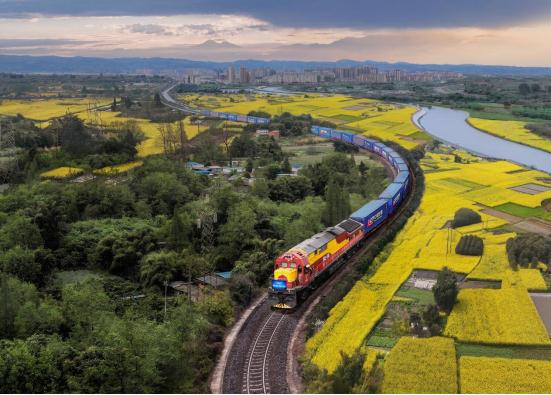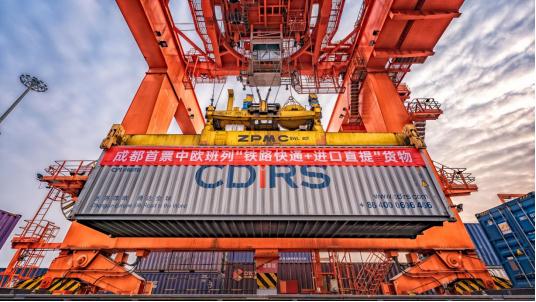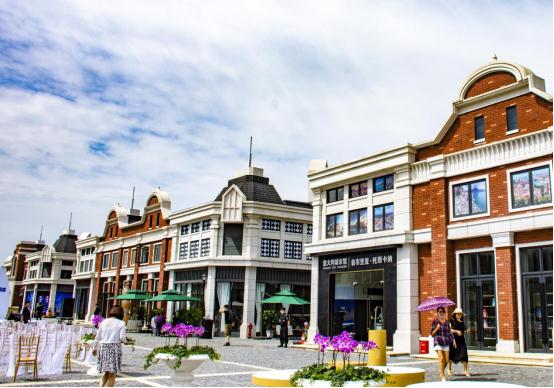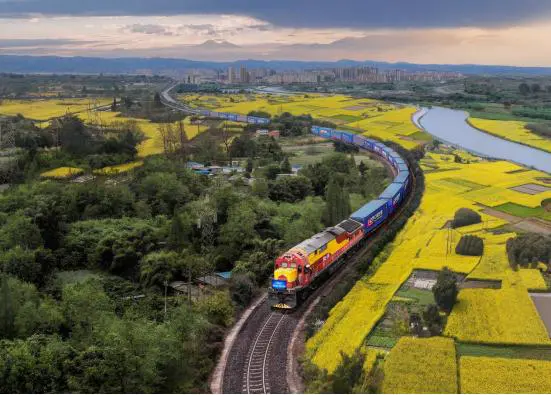Qingbaijiang district in Chengdu, Southwest China's Sichuan province, has actively taken part in the Belt and Road Initiative and made strides in accelerating construction to build itself into an international hub.
In the past decade, the district's GDP has increased by nearly 40 billion yuan ($5.56 billion) and boasted a national economic development zone, a free trade pilot zone, a comprehensive bonded zone and a landport national logistic hub. The district has successfully transformed from an old industrial zone to an open transport hub.
As the location of Chengdu International Railway Port, Qingbaijiang district plays an important role in promoting the high-quality development of the Belt and Road Initiative.
The first China-Europe (Chengdu) Railway Express departed from the railway port on April 26, 2013, which started Qingbaijiang's international journey.
Since then, the express trains have provided a guarantee for the transportation of electronics, autos, smart home appliances and advanced materials needed by European clients.

A China-Europe Railway Express departs from the Chengdu International Railway Port. [Photo provided to China Daily]
The trains have provided stable international logistic solutions for key companies such as home appliance maker Changhong, consumer electronics provider TCL, computer makers Dell and Lenovo, and carmakers Geely and Volvo.
Freight trains have shipped 'made in China' and 'made in Sichuan' products to European countries and brought back German cars, French wines, Russian wood, Polish beef and Italian furniture, which has changed the foreign trade pattern in Chengdu and China's western regions.
He Fei, marketing director of the Chengdu container center station, said: "The operation of the China-Europe (Chengdu) Railway Express makes our station busier. The number of trains in 2013 was 30 and the figure has grown to more than 2,000 in 2021. Meanwhile, the container throughput has increased from 400,000 twenty-foot equivalent units to around 1 million."
By now, the cumulative number of China-Europe trains (Chengdu-Chongqing) exceeded 20,000, accounting for about 40 percent of the China-Europe trains nationwide. Chengdu International Railway Port has an average of eight international freight trains running a day with thousands of tons of international trade goods being delivered.
The number of international freight trains departing from the railway port is still increasing. By now, the port has connected more than 100 cities at home and abroad, and formed a land-sea freight distribution system that connects with Europe, Mongolia, Japan, South Korea and members of the Association of Southeast Asian Nations.
Taking advantage of the logistics hub, Chengdu International Railway Port now focuses on the development of three major industries. They are the international supply chain, international trade and portrelated intelligent manufacturing.

A machine lifts goods at the Chengdu International Railway Port. [Photo provided to China Daily]
The port has attracted nearly 200 major projects, including Hong Kong Yuhu Group, Xiamen Xiangyu Group and Alibaba's Hema Fresh, with a total investment of more than 100 billion yuan.
Located in the Comprehensive Bonded Zone of Chengdu International Railway Port, TCL Optoelectronics Technology (Chengdu) utilizes the bonded function of the zone to produce key components such as TV modules and transport them to Poland via the China-Europe freight train.
Sun Xiuhong, head of TCL's Chengdu branch, said the company has transferred 80 percent of its European orders to Chengdu, hoping to respond more quickly to the needs of European customers through the China-Europe freight train.
More than 90 percent of the components required by TCL's six production lines in Poland's assembly base pass through the China-Europe freight train in Chengdu.
Relying on the Chengdu International Railway Port, the Chengdu-Eurasia National (Commodity) Pavilion has set up 34 characteristic country venues for Europe, Central Asia, Southeast Asia, Oceania and other regions, of which 32 venues have been put into operation.
Thanks to the stable and efficient operation of China-Europe trains (Chengdu-Chongqing), Qingbaijiang district has enhanced attraction to industries that are suitable for train transport and European markets.
The district started construction of a European industrial city in 2017, which has focused on import and export-oriented processing trade industries, aiming to build an intelligent manufacturing base.
Over the past five years, the industry city has attracted around 60 major industrial projects with a total investment of 60 billion yuan and initially formed new industrial clusters of new materials, green and low-carbon businesses and intelligent appliances.

People walk past the Chengdu-Eurasia National (Commodity) Pavilion, which has set up 34 country venues. [Photo provided to China Daily]
Back in the 1950s, Qingbaijiang was listed in a national major industry project layout and became the first district in Chengdu with a fiscal revenue of over 100 million yuan in 1990.
Now, the district has made strides in industrial transformation and upgrading. The old industrial base has grown into Chengdu's high-performance fiber material industrial functional zone.
The zone focuses on three leading industries. They are the high-performance fiber and composite materials, green building materials and new energy equipment. It has attracted 2,200 companies, including Sinotruk and Zhejiang Tianma Bearing Group.
Sinotruk Chengdu Wangpai Commercial Vehicle Company in the zone has covered the production of new energy heavy trucks, mediumsized trucks and light trucks, and become the largest new energy commercial vehicle production base in Southwest China.
The zone has accumulated rich innovation resources over the past decade. It is home to 65 new innovation platforms, 46 high-tech enterprises and other companies.
Earlier this year, Qingbaijiang district proposed the construction of a pilot production base targeting the Belt and Road markets.
With the base, the functional zone is expected to make use of the pilot test platforms to promote the commercialization of technological achievements.
(APD)
 简体中文
简体中文

